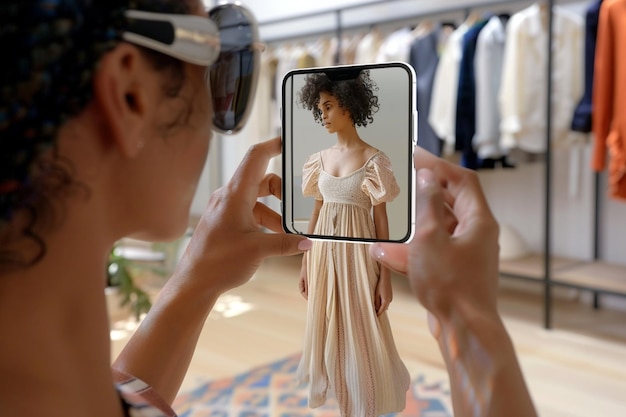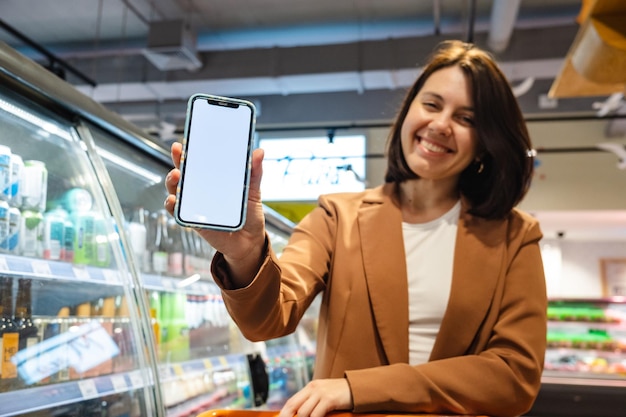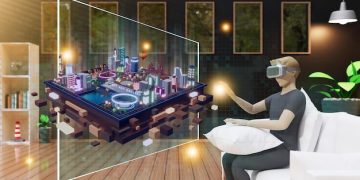Augmented Reality in Retail: How AR Enhances Shopping for US Consumers

Augmented Reality (AR) is transforming the retail landscape in the US, offering consumers immersive shopping experiences, from virtual try-ons to interactive product visualizations, ultimately increasing engagement and driving sales.
Augmented Reality (AR) in Retail: Enhancing the Shopping Experience for US Consumers is rapidly changing the way Americans shop. By overlaying digital information onto the real world, AR offers unprecedented opportunities for retailers to engage customers and drive sales. Let’s explore how AR is reshaping the retail landscape in the US.
The Rise of Augmented Reality in US Retail
Augmented Reality (AR) is no longer a futuristic concept; it’s a present-day reality impacting numerous industries, and retail is no exception. In the United States, AR is transforming how consumers interact with products, brands, and the overall shopping experience. Understanding this shift requires examining the factors driving its adoption and the benefits it offers to both retailers and consumers.
Driving Forces Behind AR Adoption
Several key factors are contributing to the increasing adoption of AR in the US retail sector. One primary driver is the proliferation of smartphones and tablets among consumers. These devices serve as the gateway to AR experiences, making it accessible to a broad audience.
Another factor is the growing consumer demand for personalized and interactive shopping experiences. Traditional retail methods often fall short in providing the level of engagement that modern consumers seek. AR bridges this gap by offering immersive, tailored interactions that captivate and inform.
- Smartphones: The widespread use of smartphones equipped with AR capabilities makes the technology readily available to consumers.
- Personalization: Consumers seek personalized experiences; AR allows retailers to tailor product displays and interactions to individual preferences.
- Interactive Engagement: AR offers interactive and engaging shopping experiences that traditional methods cannot match.
- Technological Advancements: Continuous improvements in AR technology make applications more seamless and realistic.
Technological advancements also play a crucial role. As AR technology continues to improve, applications become more seamless, reliable, and visually appealing. This enhances the user experience and encourages greater adoption rates.
In conclusion, the rise of AR in US retail is fueled by technological accessibility, consumer demand for personalized experiences, and the continuous advancement of AR technology.
Virtual Try-Ons: Revolutionizing the Fashion and Beauty Industries
One of the most compelling applications of AR in retail is virtual try-ons, particularly within the fashion and beauty industries. This technology allows consumers to virtually “try on” clothing, accessories, and makeup products from the comfort of their homes, eliminating the need for physical interaction.

Benefits of Virtual Try-Ons
Virtual try-ons offer numerous benefits to both consumers and retailers. For consumers, they provide convenience and enhance the shopping experience. Customers can experiment with different styles and products without the hassle of visiting a physical store or dealing with fitting rooms.
Retailers also benefit from virtual try-ons. By offering this technology, they can increase customer engagement, drive sales, and reduce return rates. Customers who have a better understanding of how a product will look on them are more likely to make a purchase and less likely to return the item.
- Convenience: Customers can try on products from the comfort of their homes.
- Increased Engagement: Virtual try-ons create a more interactive and engaging shopping experience.
- Reduced Returns: Customers are more likely to keep products they’ve virtually tried on.
- Cost Savings: Retailers save on costs associated with returns and physical store maintenance.
Moreover, virtual try-ons can help retailers collect valuable data about customer preferences and behavior. This data can be used to personalize marketing efforts, improve product recommendations, and optimize the overall shopping experience.
Ultimately, virtual try-ons are revolutionizing the fashion and beauty industries by providing a more convenient, engaging, and personalized shopping experience.
Interactive Product Visualization: Enhancing Purchasing Decisions
Interactive product visualization is another significant application of AR in retail. This technology allows consumers to visualize products in their own environment before making a purchase. By overlaying digital models onto real-world settings, customers can see how a piece of furniture would look in their living room or how a new appliance would fit in their kitchen.
This capability is particularly valuable for big-ticket items and products that require careful consideration before purchase. By providing a realistic preview, interactive product visualization enhances customer confidence and reduces the likelihood of buyer’s remorse.
The Impact on Home Goods and Electronics
The home goods and electronics sectors have seen substantial benefits from interactive product visualization. Retailers in these industries use AR to help customers make informed decisions about furniture, appliances, and other household items. For example, a furniture retailer might offer an AR app that allows customers to place a virtual sofa in their living room to see how it complements their existing décor.
- Informed Decisions: Customers can make more informed decisions by visualizing products in their own environment.
- Enhanced Confidence: Interactive visualizations increase customer confidence and reduce purchase hesitancy.
- Reduced Returns: Accurate visualization reduces the likelihood of returns due to size or fit issues.
- Competitive Advantage: Retailers offering AR visualizations gain a competitive edge.
Similarly, electronics retailers can use AR to showcase the size and features of televisions, speakers, and other devices. This allows customers to ensure that a product will fit in their space and meet their needs before committing to a purchase.
The impact of interactive product visualization extends beyond individual transactions. By providing a more engaging and informative shopping experience, retailers can build stronger relationships with their customers and foster brand loyalty.
In short, interactive product visualization enhances purchasing decisions by providing customers with realistic previews and greater confidence in their choices.
AR-Powered In-Store Navigation: Simplifying the Shopping Experience
Navigating large retail stores can be a challenge for many shoppers. AR-powered in-store navigation systems offer a solution by providing customers with virtual directions and real-time information about product locations. This technology can significantly simplify the shopping experience and improve customer satisfaction.
How It Works
AR-powered in-store navigation systems typically use a combination of smartphone cameras, location sensors, and digital maps. When a customer enters a store, they can use an AR app to scan their surroundings. The app then overlays virtual arrows and guides onto the live camera feed, directing the customer to specific products or departments.
In addition to providing directions, these systems can also offer real-time information about product availability, pricing, and promotions. This allows customers to make more informed decisions and take advantage of special offers. Some systems even integrate with loyalty programs, offering personalized recommendations and rewards based on customer preferences.
- Simplified Navigation: Customers receive virtual directions to specific products or departments.
- Real-Time Information: AR systems provide up-to-date data on product availability and pricing.
- Personalized Recommendations: Some systems offer tailored suggestions based on customer preferences.
- Improved Satisfaction: Easier navigation and access to information enhance the overall shopping experience.
The implementation of AR-powered in-store navigation can lead to increased sales, improved customer loyalty, and reduced operational costs. By making it easier for customers to find what they need, retailers can encourage more purchases and reduce the likelihood of customers leaving the store empty-handed.
In conclusion, AR-powered in-store navigation simplifies the shopping experience by providing virtual directions, real-time information, and personalized recommendations.

The Role of AR in Personalized Marketing and Advertising
Personalized marketing and advertising are essential for retailers looking to connect with consumers on a deeper level. AR plays a crucial role in enabling more engaging and relevant marketing campaigns. By leveraging AR, retailers can deliver customized content and offers to customers based on their individual preferences and behaviors.
One way AR enhances personalized marketing is through interactive advertisements. Instead of static images or videos, retailers can create AR ads that allow customers to interact with products virtually. For example, a clothing retailer might offer an AR ad that lets customers virtually try on different outfits or accessories.
Creating Engaging AR Campaigns
AR campaigns can also be used to deliver location-based offers and promotions. When a customer enters a store or is near a store location, they can receive AR-powered notifications on their smartphone. These notifications might include discounts on specific products, invitations to in-store events, or personalized recommendations based on their past purchases.
- Interactive Ads: AR ads allow customers to engage with products virtually, creating a more memorable experience.
- Location-Based Offers: Retailers can send AR-powered notifications with discounts or promotions when customers are near a store.
- Personalized Content: AR enables the delivery of customized information based on customer preferences and behavior.
- Enhanced Engagement: AR campaigns drive higher levels of customer engagement and brand loyalty.
The key to a successful AR marketing campaign is to provide value to the customer. AR experiences should be fun, informative, and relevant to the customer’s interests. By creating AR campaigns that meet these criteria, retailers can build stronger relationships with their customers and drive sales.
Ultimately, AR is transforming personalized marketing and advertising by enabling retailers to deliver more engaging, relevant, and valuable content to customers.
In summary, AR is revolutionizing personalized marketing and advertising by enabling retailers to deliver engaging and customized content, enhancing customer relationships and driving sales.
Challenges and Future Trends in AR Retail Adoption
While AR offers significant opportunities for retailers, there are also challenges to consider. One of the primary challenges is the cost of developing and implementing AR applications. Creating high-quality AR experiences requires specialized skills and resources, which can be a barrier for smaller retailers with limited budgets.
Overcoming the Hurdles
Another challenge is ensuring that AR applications are user-friendly and accessible to a broad audience. AR technology can be complex, and it’s important to design interfaces that are intuitive and easy to navigate. Retailers must also consider the technical limitations of different devices and ensure that AR experiences are optimized for a range of smartphones and tablets.
- Development Costs: High development costs can be a barrier for smaller retailers.
- User Experience: AR applications must be user-friendly and accessible to a broad audience.
- Technical Limitations: Retailers must optimize AR experiences for a range of devices.
- Data Security: Protecting customer data and privacy is crucial when implementing AR technologies.
Looking ahead, several trends are expected to shape the future of AR in retail. One trend is the integration of AR with other emerging technologies, such as artificial intelligence (AI) and the Internet of Things (IoT). AI can be used to personalize AR experiences based on customer data, while IoT can connect AR applications to real-world sensors and devices.
Another trend is the increasing use of AR in e-commerce. As more consumers shop online, retailers are looking for ways to replicate the in-store experience in a virtual environment. AR technologies can help bridge the gap between online and offline shopping by allowing customers to visualize products in their own homes before making a purchase.
Although challenges exist, the future of AR in retail is promising, with ongoing technological advancements and increasing consumer adoption paving the way for innovative applications.
| Key Point | Brief Description |
|---|---|
| 📱 Virtual Try-Ons | Allows customers to virtually try on clothes and accessories before purchase. |
| 🏠 Product Visualization | Lets users visualize products in their home environment for better decision-making. |
| 📍 In-Store Navigation | Provides indoor navigation using AR to help customers find products easily. |
Frequently Asked Questions
▼
AR enhances the shopping experience by allowing customers to virtually try products, visualize items in their space, and navigate stores more efficiently. This leads to increased engagement and satisfaction.
▼
Virtual try-ons offer convenience by allowing customers to try products from home, increase engagement, reduce returns, and help retailers collect valuable data about customer preferences.
▼
Interactive product visualization enables customers to see how products will look in their own environment, leading to more informed decisions, increased confidence, and reduced returns.
▼
Retailers face challenges like high development costs, ensuring user-friendliness, addressing technical limitations, and protecting customer data when adopting AR technologies.
▼
Future trends include integrating AR with AI and IoT, expanding AR use in e-commerce, and focusing on personalized and immersive shopping experiences for customers both online and in-store.
Conclusion
In conclusion, Augmented Reality (AR) in Retail: Enhancing the Shopping Experience for US Consumers is transforming the American retail landscape by providing immersive and personalized experiences. From virtual try-ons to interactive product visualizations and AR-powered in-store navigation, AR is enhancing customer engagement, driving sales, and revolutionizing the way people shop. While challenges remain in terms of cost and implementation, the future of AR in retail is bright, with ongoing innovations set to further enhance the consumer experience.





